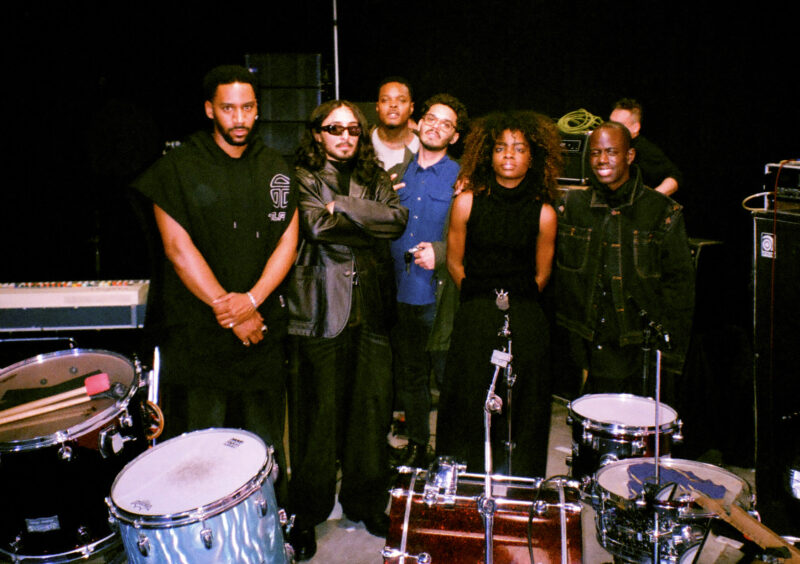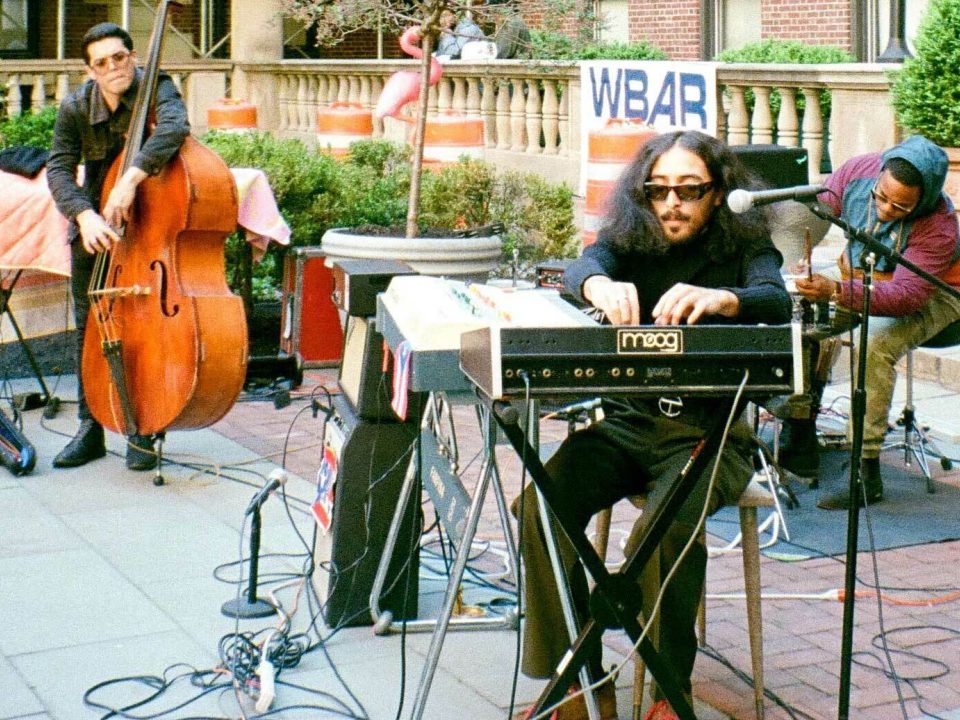Standing on the Corner is an Art Ensemble founded in 2014 by the Puerto Rican artist Gio Escobar. It takes different shapes and forms with up to 30 musicians, all of the African and Caribbean diaspora, and the music viscerally reflects on their experience. The group moves freely between jazz improvisations, excursions into dub, garage-noise, and hip-hop lo-fi collages.
As part of TUNE, Standing on the Corner performs at Haus der Kunst on 24. & 25.2.23. On this occasion, curator Sarah Miles spoke with founder Gio Escobar about creative visions, inspiration and his experiences in Europe.
Sarah Miles: Have you performed in Germany or Europe before and what were your impressions?
Gio Escobar: As an ensemble, we have never performed in Germany, but in Europe: Paris and London. Our experience as performers here has been limited to “art” arenas – that is to say programs that were set up by art institutions and that then took place in their spaces. It is my intention to not call these past events “concerts”. They feel distinctly different in my mind – perhaps more like experiments in being aliens. One thing that struck me about these experiences of performing was the way I felt the people in Europe related to us, as our audience. Back home, something I’ve often tried to disrupt is this typical relationship that exists between audience and performer that feels parasitic. It is very circus, very exploitative, and very American – “the monkeys must dance so the rich can eat”. It is an integral part of our work as an ensemble that we pose questions about this relationship and to ask who in this relationship is whose audience. That is to say: who is really watching who? In Europe, certainly informed by the environment, I felt very much treated or consumed like an “art object”. This was strange, but revelatory in the way that it is not totally dissimilar. Is the opposite of being the jester, or the fool for the masses, to be an object on a wall deemed valuable by high class collectors, curators, and criminals? I have no answer, but more questions for which I feel grateful for. I will continue to explore them as we move about the world.
In regards to Germany, my sole experience as an “artist” was not as a performer, but assisting as an arranger with a larger orchestral show that took place at the Elbphilharmonie in Hamburg. While this show was brilliant and essential to my development in some ways, I could never forget how much racism we experienced. This was illuminated in the way people may have treated you prior to knowing you were performing or an artist, and then how they would afterwards. This is a problem. The same can be said for Paris and London. Europe is often said to be more tolerant in certain scenes, but I want to assert that there is a problem.
SM: What’s the inspiration behind the name, Standing on the Corner?
GE: Standing on the Corner comes from the concept of the crossroad – abstractly, it is the central place of decision and indecision, and in relation to urban space, it is the central place of life. It is a place of safety, often relegated to churches and bodegas, or perhaps the entrance to an underworld. Maferefun Eleggua. Corners become opportunities to unify and are by nature interdisciplinary. I admit though that these notions didn’t come fully together until much later. The name was initially inspired by a group from Harlem named Children of the Corn, who did 90’s rap. This music had an impact on me and once I chose the name, I started to receive signs and see it everywhere.
SM: Your music and art has many levels. How did you and the other musicians come together, and what do you share in terms of creative vision?
GE: The first phase of the collective came together in order to organize bringing this set of recordings to life that could best be described as songs and skits that I composed over the course of several years. This would turn into our first record, which started out as singular vision, but would become the effort and inspiration of many. I have to be candid and say that collective action, while something to strive for and certainly worth struggling over, is not easy. The group functions very differently now than it did all those years back. There is a basic disharmony between the economic construct of Art/Music and collective work that thwarts one towards more conventional models of organizing. I think this is revealed in that a question over creative vision and how that is “shared” is so loaded.
SM: What and who are some of your biggest musical inspirations?
GE: My biggest musical inspirations are the various spiritual traditions I’ve come in contact with during my life, either as a practitioner or spectator. These are Black Diasporic Musics that in practice go beyond “music” in terms of their purpose or functions, for example hymnals in the Baptist Churches where I grew up playing or the Funeral dirges of Puerto Rican brass bands that sound much like those in New Orleans. I owe equal inspiration to the street poets, groups like The Last Poets and cats like Pedro Pietri, who move me on the other side and forced me to consider words and what it means to even speak.
SM: How does NYC and Puerto Rico influence the music you make?
GE: I am a representative of these two places during this distinct and complicated period in history. I understand that I come to represent the complex connection between the two, colonizer and colony, and my greatest hope is to simply be an honest messenger of what it is that I see in this moment for the future.
SM: The video brings together different music, photographs, quotes, illustrations and film, all with a broadcast/radio feel. Your website similarly features different graphics and drawings, memes and GIFs. What do you think these different forms bring to your work?
GE: The utilization of combining these different forms is to me a modern form of visualizing data except there are no numbers or figures being analyzed, but instead the “coincidental” links and narratives that tie our society together. Unseen remnants of oppression and racism are everywhere in our imagery and at the same time there is a separate, clandestine influence fighting it. We are referencing these two forces, the oppression and influences fighting it, in our work through the forms and images we bring together. By mixing them in different ways, they seem to elicit important messages.
SM: How does music and healing connect for you?
GE: I think, as a Puerto Rican and as a person whose culture is descended from Africa, there is no question about the connection between music and healing; one simply implies the other. Particularly when it comes to the drum, this is an ancient healing technology, just as one might understand honey for the Egyptians or acupuncture for the Chinese. Here today, music might be the only vehicle left for peace.
SM: Your passion for community comes across in the events you organize, your new clinic, local radio transmissions, and how you work collectively and collaboratively. Is this connection essential for your work?
GE: It is the work!
SM: Can you share something about the project you have coming up at MOMA in NYC this year?
GM: I can share that it is entitled Seven Prepared Pianos for the Seven African Powers and it is meant to imagine how spiritual forces enchant and “possess” through various forms of entertainment, considers how sacred objects are to be seen, and proposes the destruction of Western musical traditions. It is an installation that encompasses sound, moving image, and performance.
SM: And finally, what is the main inspiration behind the performance you’ve planned for Haus der Kunst?
GE: Alienation ... War, and … Surprise!

